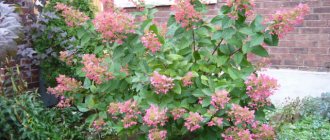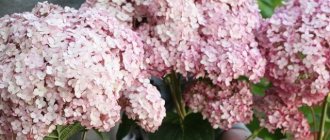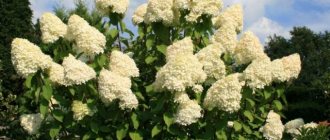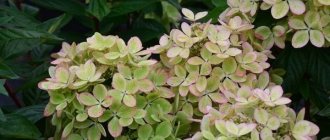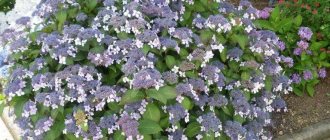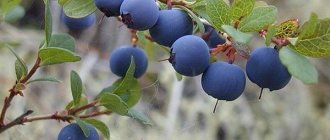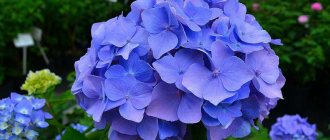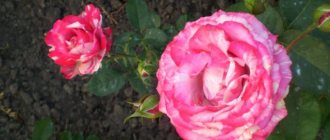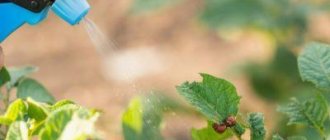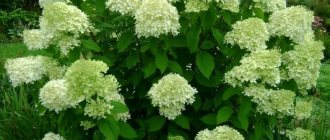History of the variety
Hydrangea Pink Lady appeared thanks to a breeding scientist from Holland - P. Zweinenburg. The time of breeding of this variety was the eighties of the 20th century. Among gardeners, this plant has won great appreciation for its quality, and the variety is considered one of the most popular and sought-after subspecies of hydrangea.
The height of Pink Lady hydrangea can reach up to two meters. The shrub itself has the shape of a fan, while its flowers are endowed with a cone-shaped shape, plus they are quite large, reaching a length of 28 centimeters on average. The foliage of the shrub has the shape of an oval of a bright, rich green hue, with teeth on the edges. The leaves are located along the entire length of the stems.
The shrub has quite powerful and strong shoots, due to which it does not lose its shape during the flowering period. And this period begins in mid-summer and ends in September. At the very beginning of the flowering period, the plant's clusters consist of small white flowers, quite airy and interesting. But in the process of blooming, the panicles become denser. The inflorescences of this variety themselves are formed from four petals and are endowed with a circle shape. During flowering, the flowers form a light pink hue.
If all the conditions and rules for planting and further caring for this plant are met, then Pink Lady hydrangea can grow in one area for several decades. This hydrangea is actively used for decorating single plantings, as well as as hedges. It looks very harmonious and stunning against the green background of the lawn. It can be used in group plantings together with other garden shrubs.
Diseases and pests
A common plant disease is powdery mildew. Its distinctive characteristic is a whitish coating on the leaves of the bush. As a rule, all infections become more active during periods of increased moisture and cold. Gardeners choose phytosporin, topaz or quadrix from special means to combat popular diseases. But still, it is easier to prevent than to treat.
Symptoms of powdery mildew
To prevent diseases of paniculate hydrangea, it is important to promptly weed between the bushes and treat Pink Lady with copper sulfate. A decoction of onion peels is used as a folk remedy. It is harmless and suitable for any time of year. Of the pests, the most dangerous is aphids. They get rid of it by using Trichopolum or Actofite. The difficulty is that all hydrangea leaves need to be treated with insecticides to avoid the spread of infection.
Hydrangea is an excellent option for creating hedges and decorating recreation areas. But how long its lush, enchanting flowering will last depends only on proper care.
Appearance and description of Pink Lady hydrangea
Pink Lady is a common variety of hydrangea (from the Latin Hydrangea Paniculata). A new paniculate variety appeared in the Kingdom of England in the 20th century. And since then it has become a favorite among gardeners, which is not surprising. A tall two-meter bush with wide spreading fan-shaped branches and voluminous flowers attracts the eye. The bright green flat leaves of hydrangea with small teeth along the edges give the plant a special appearance. The inflorescences resemble a cone and consist of two varieties of small bisexual flowers with a diameter of up to 3 cm. Thanks to the compact arrangement of the inflorescences, the bush acquires a voluminous regular shape.
What does Pink Lady hydrangea look like?
For your information! The sight of blooming hydrangea is mesmerizing. It is difficult to describe the color palette in words. This is a must see. Delicate nude shades give way to milky green, pale pink, and rich scarlet. As pollination occurs, some of the petals fall off.
Hydrangea blooms from July until frost, revealing all the beauty of the color. With proper care, bushes can please their owners for up to 10 years without replanting.
Description of the species
Hydrangea paniculata Pink Lady is a tree-like shrub with a plump crown. It sometimes grows up to 1.5-2 meters in height and up to 200 cm in volume. Its branches are decorated with large oblong dark green leaves framed with a carved edge. The tops of each branch are crowned with cone-shaped panicles of inflorescences. Inflorescences with a diameter of 15 to 30 cm are formed from small flowers on each individual stem.
Each individual flower consists of 4 round petals. They are so densely and closely located to each other that during the period of active flowering they create the effect of an air cloud emitting a sweetish aroma.
As they grow and develop, the buds change color, going through several stages: white in early summer, then light green, cream and soft pink in September. The flowering period of hydrangea lasts throughout the summer months, and sometimes until the first frost. Such a large plant has not deep, branching roots. It takes root well and grows in different types of soil.
If all agrotechnical care rules are followed, the flower will not need to be transplanted to a new location for 10 years. Hydrangea tolerates winter frosts of 30 degrees well.
Interesting. To the listed positive qualities of an ornamental plant, you can add advantages: it preserves the bush and does not fall apart during flowering, rigid branches do not bend under the weight of voluminous inflorescences. About the rose hydrangea Lady flower, a description of these features can be found in every gardener's reference book.
Frost resistance, drought resistance
Hydrangea Pink Lady is a perennial shrub with high frost resistance. The bush is able to withstand ambient temperatures down to -29–30 °C. If the shoots freeze slightly, they quickly recover.
Pink Lady paniculate hydrangea is more sensitive to drought. The plant is moisture-loving, and lack of water negatively affects the quality of flowering and the number of flowers. During long periods without water, the shrub may dry out.
Botanical description
Panicle hydrangea Pink Lady was bred by Dutch breeder Pieter Zweinenburg. Work on the variety was carried out in the 70s and 80s of the 20th century. The variety was highly praised by the Royal Horticultural Society of Great Britain. Pink Lady is recognized as one of the most popular varieties of paniculate hydrangea.
Description of hydrangea Pink Lady:
- fan-shaped shrub 1.5-2 m high;
- large, cone-shaped inflorescences, 25-30 cm long;
- The leaves are oval-shaped, bright green, serrated along the edges.
Due to powerful shoots, the bushes retain their shape when flowering. The leaves are located along the entire length of the branches. Flowering begins in mid-July and ends in September.
At the beginning of flowering, the bushes consist of small white flowers that have an elegant and airy appearance. As the flowers bloom, the panicles become denser.
Pink Lady hydrangea flowers consist of 4 petals and have a round shape. As the season progresses, the petals turn a soft pink color.
If you follow the rules of planting and care, the paniculate hydrangea Pink Lady grows in one place for several decades. The shrub is used for designing single plantings, mixborders and hedges.
Hydrangea looks impressive against the background of a green lawn. In mixed plantings it is planted next to other ornamental shrubs.
Pink Lady in landscape design
Large Pink Lady hydrangea shrubs can become a real highlight of a suburban area or a good addition to city park areas, you just have to adhere to certain landscape design recommendations. The described hydrangea can be planted both in group and single plantings, combining with other flowering crops of different sizes and colors. The main requirement in this case is the same requirements for nutrients and soil moisture levels for all crops used.
Hydrangea will look interesting against the background of coniferous crops, harmoniously combining with evergreen trees and shrubby forms of pines, cypresses, and thujas. In which part of the plot to plant flowers, each gardener can decide independently, the main thing is that in the chosen place they are provided with all the conditions for productive growth and development.
Propagation of paniculata hydrangea
Pink Lady is propagated in two ways:
- cuttings;
- layering.
The first planting option is carried out in the spring. To do this, cut off a shoot with four buds, place it in the ground and cover it with a cap to create the effect of a greenhouse. Remove the covering material when the first shoots begin to appear on the cuttings.
When planting by young layering, shoots located closer to the ground are used. They are tilted to the ground, covered with earth and left there. Throughout the warm period, the root system grows and adapts to the new location.
Important! Whatever rooting method is chosen, the main condition is frequent watering of the new seedling.
Cuttings
In order to grow a seedling from a cutting, in the spring you need to cut off a shoot with four buds and plant it in a container with an earthen mixture.
After a while, the branch will take root, after which it can be planted in open ground. The first time for acclimatization, the seedling needs to be provided with shelter.
With systematic watering, the young plant will take root in the ground. When the buds open, it can be opened.
Interesting. It is impossible to see when a shoot in a container with soil will take root. To do this, you can place the same cut shoot in a glass container with a solution that stimulates growth and observe the formation of its root system. This will help you see when the first roots appear.
A variation of cuttings is the method of using branches. Tilt the lower branch of an adult plant towards the ground, secure it with a bracket and sprinkle it with soil. With regular watering, roots form at the point of contact with the earth's surface.
By autumn, they will form a strong root system, which will allow the branch to be transplanted to a new location.
Growing from seeds
Propagating hydrangea by seed is a longer and more labor-intensive process, which an experienced gardener will be able to do.
Sowing of seeds is carried out from April to June. Grown seedlings need to be picked after the appearance of 3 leaves. Repeat picking in May, when the seedlings have grown by 7-8 cm. Care for them according to the general rules for growing hydrangeas: timely watering with settled water, fertilizing the soil no more than 2 times a month, keeping in the light, but not in direct sunlight.
The task of growing hydrangea from seeds is selection. You can use the seed shoots to create an indoor flower. If there are no cuttings or seedlings, then seedlings can also be grown on the site according to the general scheme. Only Pink Lady can be planted after two years.
Planting hydrangea
The plant must be planted in a prepared place. A substrate is pre-prepared, taking into account the characteristics of the soil. When choosing a site, take into account its illumination and the presence of protection from the wind.
Boarding time
We have already said that this marvelous plant, Pink Lady hydrangea, is unpretentious. Planting and caring for it will require minimal effort from the owner. The best time to plant a plant is spring, although you can do this work in the fall, however, in this case some additional measures will be required, which we will discuss below.
By planting Pink Lady hydrangea in the spring, you give the shrub an additional chance to quickly adapt in the summer and take root in the climatic conditions typical for your region. If you decide to plant hydrangea in the fall, then the seedling must be covered for the winter. This is done without fail, regardless of the frost resistance of the plant.
Selecting a location
For Pink Lady hydrangea, it is very important to choose the right site for planting, where the plant will feel quite comfortable and at the same time fit well into the landscape. For this variety of paniculata hydrangea, sunny areas, but well protected from the wind, are most suitable. Although Pink Lady hydrangea tolerates partial shade, in this case it does not reveal all its beauty: the flowers lose their exquisite pink hue. In addition, flowering activity decreases.
The soil
This variety of hydrangea does not really like sandy soil, which should definitely be taken into account when choosing a place for planting. For this plant, the drainage properties of the soil are important, but they should not be pronounced. This is explained by the fact that this variety of hydrangea is a moisture-loving plant; it will tolerate short-term excess moisture, but drought can destroy its root system.
Preparatory stage
Paniculata Pink Lady hydrangea is best planted on the south side of the site. In hot regions, the shrub is placed in partial shade. With constant exposure to the sun, the decorative properties of the inflorescences are lost.
When planted next to a fence or building, the shrub will receive the necessary partial shade and protection from the wind. It is placed away from fruit trees, which take many useful substances from the soil.
Important! Pink Lady hydrangea is unpretentious and can grow in any type of soil.
Abundant flowering is ensured by planting the plant in fertile loamy soil. Heavy clay soils are fertilized with humus. Nutrients are quickly washed out of sandy soil, so peat and compost are added to it.
Hydrangea is demanding on soil acidity. The shrub develops well in neutral and slightly acidic substrate. When digging up soil, you should avoid using chalk, dolomite flour, lime and ash.
Seedling preparation
The Pink Lady hydrangea needs root pruning before planting. The description, which can be found in publications on floriculture, recommends cutting off annual shoots, leaving only 3-5 buds on them.
Step by step planting process
Having chosen a convenient place for planting ornamental shrubs, you should prepare a suitable plot of land. Although the plant takes root well in various soils, it blooms more profusely on fertile loams. If there is a lot of clay in the ground, you need to add humus. It is necessary to add compost and peat to sandstones to enrich the substrate, since it poorly retains useful minerals.
Planting in open ground
Hydrangea Candelight - description and cultivation of the variety in open ground
Planting hydrangea in open ground is possible in the spring, before the buds appear, or in the fall after the leaves fall. The first landing option is the most acceptable. The main development of the root system and rooting occurs faster at above-zero temperatures. Spring planting promotes rapid flowering. Transplanting hydrangeas in the fall is more difficult. A fragile seedling requires shelter from low temperatures. As the experience of gardeners shows, in the second case, young bushes take root worse.
Note! It is worth choosing strong seedlings over 3 years old without visible damage. In this case, the chances of flowering in the first year increase.
The choice of location should be taken seriously. The picky hydrangea Pink Lady prefers sunny places for rooting and does not like drafts. Under the rays of the scorching sun, the flowers turn pale. Ideally suited for planting are places on the south side, next to an object that creates light shade, but not near trees, otherwise the roots will not receive the full amount of nutrients.
Planting young seedlings in spring
Hydrangea Pink Lady shows its best qualities well when planted in neutral soil without the presence of alkali, preferably loam. Sandy terrain is also not suitable.
Two days before planting, hydrangea roots are pruned and disinfected, treated with a growth stimulator with the addition of potassium permanganate. The hole is dug in advance. A day before planting, about 20 liters of water are poured there. When planting, it is important to straighten the roots of the plant. You need to fill the soil carefully, trying not to compact it. After this you need to water again. When planting in groups, the distance between bushes is maintained at least 3 m.
Important! You cannot plant hydrangea next to bulbous plants. Digging up the bulbs annually may damage the bush's wide root system.
Care
Caring for young plantings and mature bushes is not difficult. However, to obtain lush flowering, hydrangea requires compliance with certain care rules. These include regular watering, fertilizing, loosening and mulching.
Watering mode
Hydrangea is a moisture-loving plant that requires abundant watering. The soil around the bush should not be allowed to dry out. For weekly morning or evening watering, up to 30 liters of water should be poured under an adult bush. In cool rainy weather, reduce the rate to 10 liters.
High-quality watering determines how the inflorescences will form and whether the entire bush will develop. After each watering you need to loosen the soil. To prevent the roots from opening, sprinkle them with a mixture of dry leaves or sawdust, peat and humus.
Top dressing
The roots of the pink lady hydrangea are close to the surface, so they cannot get their food from the ground. Therefore, the ornamental bush must be supplied in a timely manner with both organic matter and minerals. You need to feed the plant 4 times a year, adding a variety of fertilizers to the soil. Meals are provided according to the following scheme:
- spring feeding (before the first buds open) consists of bird droppings or mullein in a ratio of 1:15;
- summer fertilizer during the formation of inflorescences (ammonium nitrate, superphosphate and water in proportions 35 g: 20 g: 10 l);
- at the end of July - beginning of August, fertilizing with special granules (30 liters of solution prepared according to instructions for each bush);
- in the fall, at the end of flowering, add 50 g of superphosphate and potassium salt to each plant.
Important! Do not use nitrogen-containing fertilizers.
Mulching and loosening the soil
To prevent the roots from being exposed during watering, gardeners advise laying a mulch layer. Peat, humus, dry sawdust or leaves are suitable. The layer of natural material is 20–30 cm. Mulching helps retain moisture in the soil longer.
You need to loosen the soil around the Pink Lady paniculata bush regularly after frequent watering so that air can flow freely to the roots. Each time after water procedures, the earth is loosened until a crust has formed.
During the flowering period
In the active color phase, the main task of the gardener is to create comfortable conditions for the preservation of bushes and inflorescences.
In addition to complying with all agrotechnical requirements, plants must be protected from pests and diseases. During summer cold snaps and rains, the bushes are affected by powdery mildew.
Caring for the Pink Lady variety
Hydrangea Magical Fire - description and cultivation of the variety in open ground
Pink lady hydrangea does not require labor-intensive care. Shrubs are unpretentious. The difference will only appear in the characteristics of flowering. Well-groomed hydrangea, with proper watering and timely fertilization, blooms brighter, more magnificently and longer. Such inflorescences are much larger, and the bush itself looks formed and neat.
Watering
The paniculate species is moisture-loving. Drying out of the soil immediately affects the appearance. Every week you need to pour at least 30 liters of warm water under the bush in hot summers and 10 liters in cool times. This should be done in the morning or evening. Water is poured closer to the roots so that it does not fall on the leaves and flowers.
Bushes require abundant watering
Top dressing
Nutrients must be added at least 4 times a year. These can be organic fertilizers or mineral ones. The first application occurs in the spring, when the buds have already formed, but have not yet bloomed. For organic feeding, mix one part bird droppings or mullein with 15 parts water.
Next time fertilizing is added in the summer. During the formation of buds, 10 liters of water are poured under the bush with the addition of 35 g of ammonium nitrate and 20 g of superphosphate. In mid-July, the soil near Pink Lady is fertilized with hydrangea granules. The solution is prepared in a volume of 30 liters per bush. Each manufacturer indicates the proportions on the packaging.
The fourth stage of fertilization is the final one. After the hydrangea has bloomed, potassium salt and superphosphate, 50 g of each, are poured under the plant. It is important that the fertilizer composition does not contain nitrogen.
Shrub pruning
The procedure for pruning this variety of hydrangea is accessible even to a novice gardener. It is important to hold this event in the last days of March. The bush is inspected and all weakened, diseased branches are removed. In an old plant, new growth is shortened so that it rises no more than 6 cm above the soil. This will help the plant renew itself faster.
Pruning is carried out in early spring
Note! Proper crown formation involves pruning all branches so that about 9 new shoots remain on each.
Preparing for winter
When switching to winter time, the capricious Pink Lady is insulated: Dry flowers are removed, leaf litter is raked to prevent diseases, and a crown is formed. All diseased and damaged branches are cut off. Healthy strong shoots are shortened to the required length. Watering the plants is gradually stopped. There is no need to fertilize hydrangea during the cold season.
The root system should overwinter in a warm place. Mullein or dried leaves are suitable for these purposes. In regions with cold winters, young seedlings are wrapped in burlap or special non-woven material. When snow falls, you can cover the bush with it on top of the shelter, giving the hydrangea the shape of a snowdrift.
Problems during cultivation
Since pink hydrangea is a beautifully flowering shrub, the main problem that worries gardeners is “problems” with flowering. Sometimes a plant produces only foliage; at first glance it is not clear why this happened. The reasons for this phenomenon can be very diverse: unsuitable environmental conditions, infrequent feeding or even neglect of them, and others. But the most likely reason for the lack of flowering is severe pruning. If you overdo it with the spring “haircut,” then the hydrangea can intensively begin to develop its own root system, perceiving pruning as a signal of external unfavorable conditions. It is also important to remember that transplanted plants may not bloom in the first year, as they are recovering from stress.
Hydrangea leaves often turn yellow. This problem occurs as a result of too little or too much light or moisture, too little acidity in the soil, drafts or insufficient nutrients in the soil. It is quite difficult to resolve the issue of yellowing leaves, because it is not always possible to immediately determine the cause. Therefore, you need to gradually try to improve the growing conditions of the bush and observe the foliage. If some measure has shown effectiveness, it is necessary to remember the cause of the problem with the leaves and neutralize the negative factor.
Pink hydrangea is resistant to diseases and pests, but sometimes suffers from powdery mildew, which also causes the leaves to turn yellow and become covered with a whitish coating. You can fight it with the old and proven method - Bordeaux mixture. This shrub can be favored by slugs. A layer of mulch made from pine sawdust and industrial products against these pests will save you from them. In pursuit of a quick color change, many gardeners too often water hydrangea with substances that change the color of the inflorescences. It must be remembered that heavy application of aluminum or chalk, as well as other catalysts for changing the color of flowers, can harm the roots of the plant.
